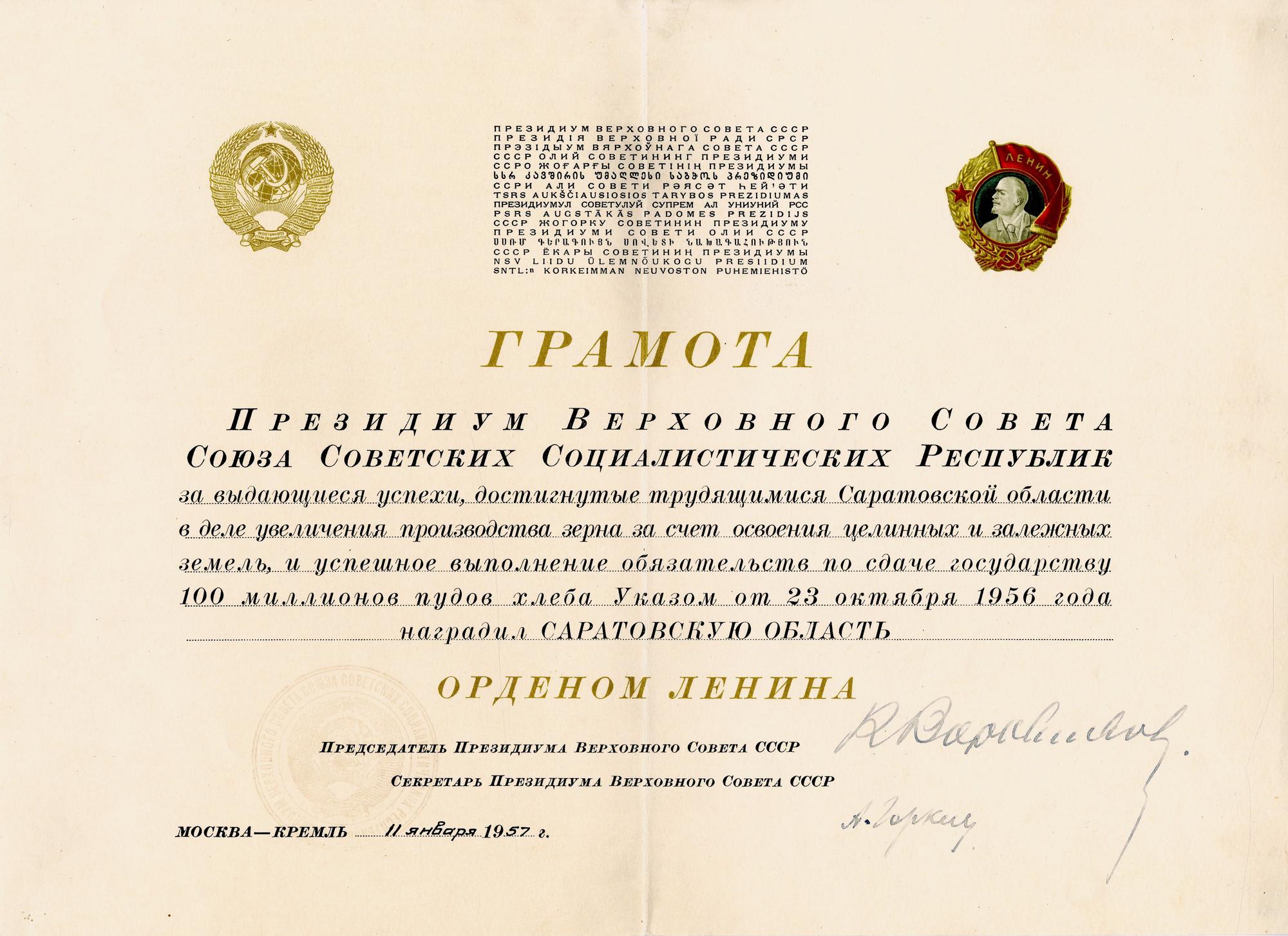The exhibition, ‘Rarities of the Saratov Regional Museum’, includes a Diploma of the Presidium of the Supreme Soviet of the USSR regarding the conferment of the Order of Lenin to Saratov Region. The diploma was awarded for the outstanding efforts of the workers of Saratov Region, who managed to increase grain production by developing virgin and long-abandoned fields and successfully fulfilled their obligation to produce 100 million poods (16.3 kilograms) of bread.
The availability of bread in the early 1950’s was of grave concern. The average grain yield was less than 9 quintals (900 kilograms) per hectare. In 1953, around 31 million tons of grain was produced, however consumption amounted to over 32 million tons. In 1954, a resolution was passed at the plenary session of the Central Committee of the Communist Party of the Soviet Union ‘regarding future increases in grain production in the country and the development of virgin and long-abandoned fields.’ Following this, a huge development of new fields began across the country, including in Saratov Region.
Saratov Region had large swathes of un-ploughed land in Zavolzhye. In 1954, 503,000 hectares of virgin and previously un-ploughed land were developed, as well as 330,000 ‘planned’ hectares. The fields were cultivated by 44 state farms and dozens of Zavolzhye’s collective farms. In Perelyubsky, Ozinsky, Dergachevsky, Fedorovsky, Novouzensky and Yershovsky districts, 13 new state farms operated successfully. They had over a thousand tractors and combines at their disposal. Young people, who had come to cultivate this land as part of a Komsomol assignment, participated the most in the cultivation of new fields. In 1954, over 30,000 Komsomol members from all around the country took part in the spring sowing. In 1955, over 16,000 specialists were sent to work permanently at the tractor depots, collective farms and state farms.
The cultivation of this previously un-ploughed land lead to larger grain harvests. In 1956, residents of Saratov Region replenished the country’s stores with over one million poods of grain, including 62 million poods of the highly-prized Volga wheat. Over 6,000 agricultural workers in Saratov Region were awarded for their selfless cultivation work between 1954 and 1955.
The availability of bread in the early 1950’s was of grave concern. The average grain yield was less than 9 quintals (900 kilograms) per hectare. In 1953, around 31 million tons of grain was produced, however consumption amounted to over 32 million tons. In 1954, a resolution was passed at the plenary session of the Central Committee of the Communist Party of the Soviet Union ‘regarding future increases in grain production in the country and the development of virgin and long-abandoned fields.’ Following this, a huge development of new fields began across the country, including in Saratov Region.
Saratov Region had large swathes of un-ploughed land in Zavolzhye. In 1954, 503,000 hectares of virgin and previously un-ploughed land were developed, as well as 330,000 ‘planned’ hectares. The fields were cultivated by 44 state farms and dozens of Zavolzhye’s collective farms. In Perelyubsky, Ozinsky, Dergachevsky, Fedorovsky, Novouzensky and Yershovsky districts, 13 new state farms operated successfully. They had over a thousand tractors and combines at their disposal. Young people, who had come to cultivate this land as part of a Komsomol assignment, participated the most in the cultivation of new fields. In 1954, over 30,000 Komsomol members from all around the country took part in the spring sowing. In 1955, over 16,000 specialists were sent to work permanently at the tractor depots, collective farms and state farms.
The cultivation of this previously un-ploughed land lead to larger grain harvests. In 1956, residents of Saratov Region replenished the country’s stores with over one million poods of grain, including 62 million poods of the highly-prized Volga wheat. Over 6,000 agricultural workers in Saratov Region were awarded for their selfless cultivation work between 1954 and 1955.



